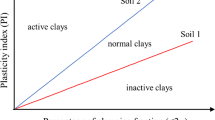Abstract
Soils containing expansive clays undergo swelling that can be both detrimental and beneficial in various applications. In the Arabian Gulf coastal region, natural heterogeneous soils containing clay and sand (tills, shales, and clayey sands) support most of the civil infrastructure systems. Likewise, mixes of clay and sand are used for local earthwork construction such as roads and landfills. A clear understanding of the swelling behaviour of such soils is pivotal at the outset of all construction projects. The main objective of this paper was to understand the evolution of swelling with increasing clay content in local soils. A theoretical framework for clay–sand soils was developed using phase relationships. Laboratory investigations comprised of mineralogical composition and geotechnical index properties of the clay and sand and consistency limits, swelling potential, and morphology of clay–sand mixes. Results indicated that soil consistency of mixes of a local expansive clay and an engineered sand depends on the weighted average of the constituents. Mixes with 10% clay through 40% clay capture the transition from a sand-like behaviour to a clay-like behaviour. Influenced by the initial conditions and soil matrix, the swelling potential of the investigated mixes correlated well with soil plasticity (SP(%) = 0.16 (I p)1.188). The parameters sand void ratio and clay–water ratio were found to better explain the behaviour of blended clay–sand soils.










Similar content being viewed by others
References
Abduljauwad SN (1994) Swelling behaviour of calcareous clays from the Eastern Province of Saudi Arabia. Quart J Eng Geol 27(4):333–351
Abduljauwad SN, Al-Sulaimani GJ, Basunbul IA, Al-Buraim I (1998) Laboratory and field studies of response of structures to heave of expansive clay. Geotechnique 48(1):103–121
Aiban SA, Al-Abdul Wahhab HI, Al-Amoudi OSB, Ahmed HR (1998) Performance of a stabilized marl base: a case study. Construct. Build. Mater. 12(6–7): 329–340
Al-Shayea NA (2000) Inherent heterogeneity of sediments in Dhahran, Saudi Arabia – a case study. Eng Geol 56(3–4):305–323
Azam S (2003) Influence of mineralogy on swelling and consolidation of soils in eastern Saudi Arabia. Can Geotech J 40(5):964–975
Azam S (2006) Large-scale odometer for assessing swelling and consolidation behaviour of Al-Qatif clay. In: Al-Rawas AA, Goosen MFA (eds) Expansive soils: recent advances in characterization and treatment. Balkema Publishers-Taylor and Francis, The Netherlands, pp 85–99
Bell FG (1993) Engineering geology. Blackwell, Oxford
Cassagrande A (1948) Classification and identification of soils. Trans ASCE 113:901–930
Chen FH (1988) Foundation on expansive soils. Elsevier Scientific Publishing Company, Amsterdam, The Netherlands
Dakshanamanty V, Raman V (1973) A simple method of identifying an expansive soil. Soils Found Jpn Soc Soil Mech Found Eng 13(1):97–104
Daniel DE, Wu YK (1993) Compacted clay liners and covers for arid sites. J Geotech Eng 119(2):223–237
Dixon D, Chandler N, Graham J, Gray MN (2002) Two large-scale sealing tests conducted at Atomic Energy of Canada’s underground research laboratory: the buffer-container experiment and the isothermal test. Can Geotech J 39(3):503–518
Fredlund DG, Rahardjo H (1993) Soil mechanics for unsaturated soils. John Wiley and Sons Inc., New York
Holtz WG, Gibbs HJ (1956) Engineering properties of expansive clays. Trans ASCE 121:641–677
Holtz WG, Kovacs WD (1981) An introduction to geotechnical engineering. Prentice-Hall Inc., Englewood Cliffs, NJ
Komine H, Ogata N (2003) New equations for swelling characteristics of bentonite-based buffer materials. Can Geotech J 40(2):460–475
Mitchell JK, Soga K (2005) Fundamentals of soil behavior, 3rd edn. John Wiley and Sons, Inc., NY, USA
Pusch R (1999) Microstructural evolution of buffers. Eng Geol 54(1–2):33–41
Seed HB, Woodward RJ Jr, Lundgren R (1962) Prediction of swelling potential for compacted clays. J Soil Mech Found Div ASCE 88(SM3):53–87
Seed HB, Woodward RJ Jr, Lundgren R (1964) Clay mineralogical aspects of the Atterberg limits. J Soil Mech Found Div ASCE 90(SM4):107–131
Simons H, Reuter E (1984) Physical and chemical behaviour of clay-based barriers under percolation with test liquids. Eng Geol 21(3–4):301–310
Sivapullaiah PV, Sridharan A, Stalin VK (1996) Swelling behaviour of soil-bentonite mixtures. Can Geotech J 33(5):808–814
Skempton AW (1953) The colloidal activity of clay. In: Proceedings of the third international conference on soil mechanics and foundation engineering, London, vol 1, pp 57–61
Smart P, Tovey NK (1982) Electron microstructure of soils and sediments: techniques. Oxford University Press, Oxford
Van der Merwe DH (1964) The prediction of heave from the plasticity index and percentage clay fraction of soils. Civil Eng S Afr 6(6):103–107
van Olphen H (1991) An introduction to clay colloidal chemistry, 2nd edn. Krieger Publishing, Florida
Wickland BE, Wilson GW (2005) Research of co-disposal of tailings and waste rock. Geotech News 23(3):35–38
Windal T (2002) Design of tunnels in swelling soils: determination of swelling soil properties. Fluid Dyn Fluid-Struct Interact High Explos Detonat 446(1):81–88
Wood DM (1992) Soil behaviour and critical state soil mechanics. Cambridge University Press, London
Yong RN (1999) Soil suction and soil-water potentials in swelling clays in engineered clay barriers. Eng Geol 54(1–2):3–13
Acknowledgments
The author acknowledges the support of King Fahd University of Petroleum and Minerals for providing laboratory space and computing facilities. Thanks to Dr. J.D. Scott, Professor Emeritus at the University of Alberta, for his invaluable suggestions during the write up of the manuscript.
Author information
Authors and Affiliations
Corresponding author
Rights and permissions
About this article
Cite this article
Azam, S. Study on the swelling behaviour of blended clay–sand soils. Geotech Geol Eng 25, 369–381 (2007). https://doi.org/10.1007/s10706-006-9116-1
Received:
Accepted:
Published:
Issue Date:
DOI: https://doi.org/10.1007/s10706-006-9116-1




